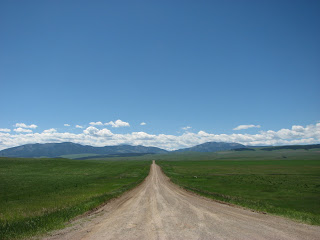June 9, 2013
The next morning was once again sunny.
I headed west and passed an espresso place, kind of out in the middle of nowhere, so I turned around and talked for 15 minutes to the lady who ran this business and who had owned it for 13 years. It was named after the highway, like Espresso 37 or something like that. She had an interesting story. Her husband (now her ex-husband from what I could tell) was a nuclear physicist but was born near a little town west of John Day. He worked at Oakridge in Tennessee (where they met I think) and they had also lived in South Haven, Michigan, when he worked on the plant there (the one with all the troubles). So she knew Michigan.
She loves her work. Not once does she awaken at "5 a.m. and hate to go to work." She lives just "up on that mountain" which she pointed out to me and which was a high hill across the road. Her husband or ex-husband retired and moved back and became the county sheriff. He had just retired from that job. She was attractive in that western madam way...blond with jewelry and bright clothes, carrying a few extra pounds, but totally at ease with herself. She talked me into checking out the Painted Hills, part of the John Day Fossil Beds. So I did. It was off the main road about six miles and worth seeing. There are always signs warning of rattlesnakes throughout much of the drier parts of the west on public lands as they were here also. The hills have horizontal reddish and various sand-colored striations. They are quite smooth and odd but beautiful. One could explore this region for days.
On and on until there was a sign saying "Wreck Ahead" and all traffic was stopped for about an hour in both directions. The road had been winding through forests and canyons, alternating with grasslands and ranches. Drivers got out of their vehicles, many of which were RVs. It was a gorgeous spot with no bugs, which I know I keep mentioning but imagine the most glorious Michigan day in the woods with no insects. A tiny creek ran at the botton of the canyon on one side, and huge ponderosas and other pines went up the hillside on the other. We all chatted and some of the guys joked about just camping out here as it was so beautiful. A couple brought out camp chairs for the duration. One guy wondered if it was raining in Portland where he was headed and where he lived because if it was, he would change his plans to return that day. I got that completely.
Finally, we moved on and saw two badly smashed cars. I looked this accident up online when I got to Eugene later that day. One driver was distracted it said, by "something outside of the car" and crossed the centerline. Six people had been transported to hospitals, two with serious but not "life-threatening" injuries which was good. I, of course, mused on the circumstances off and on for several hours. How a moment of inattention, especially on roads which are unforgiving, can have diastrous results.
At Sisters, Oregon, I was hungry but there was a rodeo and the town was buzzing. I couldn't find a parking place near a convenience store to buy some road food, so I went to a grocery store, but it was a discount store and I wanted a yuppie one. I walked across the parking lot and found myself in a bar that served food and had quesadillas.
I started over the Cascasdes on a route that wasn't yet opened for the summer and only realized it after ten miles so had to return to Sisters and take the alternate route. This area, on the lower eastern slopes of the Cascades has what I think of as ponderosa savannah. These straight tall trees have bark consisting of large reddish-brown, roughly rectangular pieces, and branches that begin very high up so there are open sunny and grassy spaces beneath the trees.
As I drove higher, I passed through lava fields which are amazing. There are miles and miles of black lava in rough, various-sized geometric chunks. There are occasional trees here and there which have somehow found enough nourishment and are growing out of this landscape of huge blocks of tumbled lava. One side of the highway is natural forest and the other is where the lava flow stopped but which extends to the horizon in that direction.
Then down the other side of the Cascasdes to Eugene, through millions of magnificent trees and shrubs and flowers and grasses and mosses. It is much more moist on this side, very noticeably different than the dry east side. I followed the beautiful McKenzie river to Eugene where it flows into the Willamette, the large river that runs through Eugene north to Portland and eventually into the Columbia.
The rivers are reason enough to travel the west...all that fast, lovely water, glinting silvery, more so in the sunshine, but also sparkling on misty grey days, with rocks and riffles and gravel bars and sandy beaches, with old weathered driftwood and newly uprooted trees continually changing the way the river runs.







